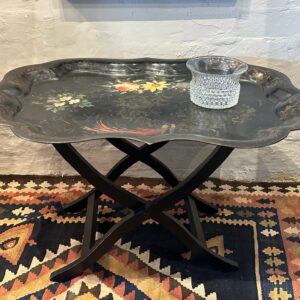Showing 17–31 of 31 resultsSorted by latest
18th century English Oak refectory/sofa/side table
The well patinated thick, single plank top above a rectangular moulded skirt, resting on well-turned legs, joined by bold stretchers.
H.76cm
W.151cm
D.74cm
19th century English floral gilt decorated & painted tin tray on original black painted folding stand.
The shaped moulded edge retaining much of the original gilt design.
The painted surface includes a peacock and flowers.
Fantastic condition. Cleaned and waxed in our workshop this morning.
C.1890
H.44cm
W.78cm
D.59cm
A Nest of English Oak Tables
This nest of 1920s oak side tables have been around for many many years.
I purchased them around 15 years ago, my late father Neville stripped the lacquered finish off for me, for some reason he removed all the tops?
So over the years, we found some tops, the bases, moved from store to storeroom, bloody bloody!!
First half 19th Century English faded Rosewood sofa/side table
The figured book matched, rectangular top above two narrow drawers.
Retaining the original turned handles, on a well turned, finely carved decorative base.
C.1830
H.74cm
W.122cm
D.61cm
First quarter 18th century English oak gate-leg table.
The two plank rectangular central top, with two, two plank drop sides.
Having a fine scratch mould 1cm from plain edge.
One end skirt having a later replaced or rebuilt 19th century drawer, with a brass handle.
The base with graceful cotton-reel legs, joined by bobbin-turned stretchers.
Fantastic overall deep oak colours and patination.
C.1720
H.72cm W.112cm D.55cm
Opened: W.142cm D.112cm
19th century revival of a George III long demi lune mahogany side/hall table.
They didn’t make them this narrow in the 18th century. Much shorter and deeper.
This was made to suit the narrow Victorian hallways.
The bowed single plank, reeded-mould top, above a narrow x-banded skirt,
having a single figured mahogany central drawer, with ebony stringing and later but appropriate circular brass plate,
ring handles, covering where the wooded turned handles originally sat. With faux drawers to each side.
Resting on turned tapered legs.
Good overall colour and patination.
18th Century Oak Lowboy
Some recent re purchases I sold 20 years ago.
Even though retiring soon, it’s impossible to not buy these magnificent pieces back.
18th century oak lowboy.
H.74cm W.90cm D.65cm
All in need of a good re-wax finish.
A rare George III solid yew-wood pembroke table – UK1881
I’ve enjoyed having this beautiful 18th century English yew-wood side table in my apartment for the past few years.
Being a dealer and having such special pieces, I have the enjoyment of living with, then selling once replacing.
I’ll truly miss this table, however living in an apartment forces one to cull!
This table will be back in my showroom next week.
May be selling soon – in my apartment – AA1255
Stock AA1255
19th Century French oak desk of small proportions
The tick two plank top having several knots and a matched sap wood join between planks above a plain fieze with a single moulded drawer to the front retaining the original lock and escutcheon. Resting on square tapered legs.
1870 – 1900
H: 2′ 5″ –
W: 3′ 3″ – 100 cm
D: 2′ 3″ – 66 cm
Mid 19th Century English Country Oak Low Boy, in George II Style AA2195
Mid 19th Century English Country Oak Low Boy, in George II Style
The rectangular moulded two-plank top, above two short, then one long cock-beaded drawers, retaining the original brass-work.
Resting on long cabriole legs, terminating on a round pad foot.
C.1860 In style of 1740
H.70cm
W.81cm
D.50cm
Table in workshop waiting on a good clean and re-waxing.
A rare 18th Century English mahogany Chippendale carved triple tier games table
Stock CRC700
A rare 18th Century English mahogany Chippendale carved triple tier games table.
This rare example opens to become four tables. First of all a rectangular side table, secondly opening to a mahogany tea table, next to be a baize toped card table and again opening to a backgammon/chess table, then a lifting lid for cards and other playing equipment.
Note: The triple fork hinges to the tops and the exceptional original carving over all. This rare example should be a museum piece.
C. 1770
H: 2′ 7″ – 78 cm
W: 2′ 9″ – 84 cm
D: 1′ 5″ – 43 cm
Early 19th Century English country fruitwood and ash occasional table – AA1481
Stock AA1481
Early 19th Century English country fruitwood and ash occasional table.
The rectangular fruitwood top on a well turned support, on three fruitwood downswept legs.
C 1830
H. 2’ 4” – 70 cm
W. 1’ 12” – 58 cm
D. 1’ 6” – 44 cm
A pair of George III style figured oak bedside tables
A pair of George III style figured oak bedside tables
H:70 cm W: 35 cm D: 35 cm
18th Century English oak lamp table – AA1494
Stock AA1494
18th Century English oak lamp table.
The circular moulded top supported by a gun barrel turned column, resting on three downswept cabriole legs terminating in pad feet.
1760 – 1790
H: 2′ 3″ – 68 cm
Diameter: 1′ 7″ – 48 cm














